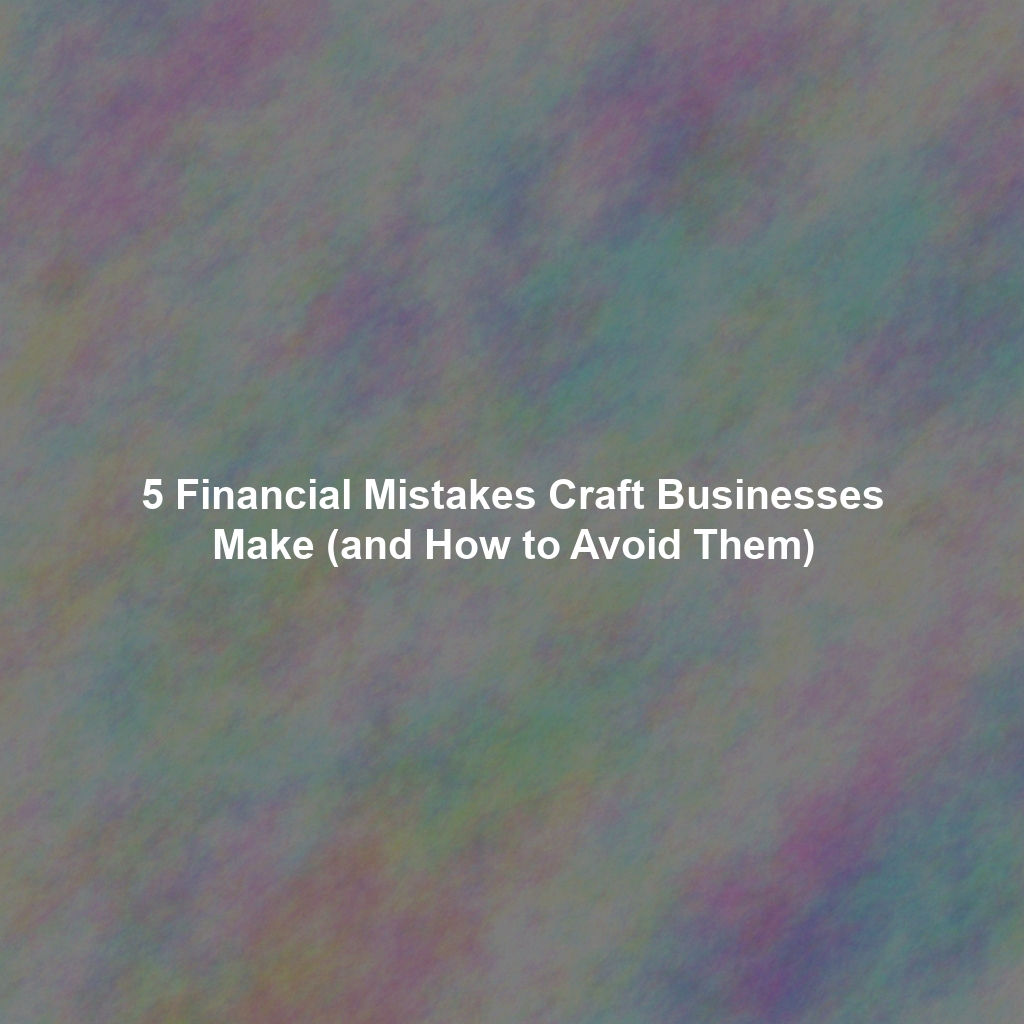5 Financial Mistakes Craft Businesses Make (and How to Avoid Them)
So, you’ve turned your passion for crafting into a business? That’s fantastic! You get to spend your days creating beautiful, unique things, and hopefully, making some money while you’re at it. But let’s be real – the financial side of things can be a real headache. It’s easy to get swept up in the creative process and forget about some essential money management stuff. I totally get it, I’ve been there! That’s why I want to share 5 common financial mistakes I see craft businesses making, and more importantly, how *you* can avoid them.
1. Not Tracking Material Costs Accurately
This one’s a biggie! It’s tempting to think, “Oh, this little thing of glitter was only $2, no sweat.” But those “no sweat” purchases add up *fast*. Not accurately tracking your material costs is like trying to bake a cake without measuring anything – you might end up with something edible, but it probably won’t be great.
Why is this a problem?
- Inaccurate Profit Margins: If you don’t know exactly how much your materials cost, you can’t accurately calculate your profit margin. You might *think* you’re making a good profit when you’re actually barely breaking even, or even losing money! Yikes!
- Poor Pricing Decisions: Knowing your material costs is key to setting prices that cover your expenses and allow you to make a profit.
- Inventory Management Nightmares: Without tracking, you won’t know when you’re running low on supplies, which leads to frantic last-minute orders and potentially missed sales.
How to Avoid It:
- Spreadsheet Power: Create a simple spreadsheet to track *every* material purchase. Include the date, vendor, item description, quantity, and cost.
- Inventory System: Get a basic inventory system going. When you use materials for a project, deduct them from your inventory.
- Consistent Updates: Make it a habit to update your material costs regularly. Prices change, and you’ve gotta stay on top of it.
- Consider Automation: If you’re selling on platforms like Etsy or Shopify, think about using a tool like TrueCraft. It’s designed to automatically track your material costs and calculate your true profit margins by syncing with your sales data. This can save you a ton of time and make sure everything’s accurate.
2. Underpricing Products
This mistake often comes from worrying about charging “too much.” You might think, “If I price my items higher, no one will buy them!” But underpricing your products is a *really* good way to hurt your business. You deserve to be paid fairly for your time, skill, and materials.
Why is this a problem?
- Undervalued Time: You’re basically working for less than minimum wage (or even for free!). Your time and skills are valuable!
- Unsustainable Business: If you’re not making enough profit, you won’t be able to reinvest in your business, pay yourself, or handle unexpected costs.
- Perception of Quality: Believe it or not, sometimes lower prices can actually turn customers *off*. People often link higher prices to better quality.
How to Avoid It:
- Calculate Your Costs: Figure out exactly how much your materials, labor (be honest about how much your time is worth!), and any overhead expenses (like rent, utilities, and marketing) cost you.
- Research the Competition: See what other craft businesses are charging for similar things. Don’t undercut them just to make a sale. Find a price that’s competitive, but also profitable for *you*.
- Value Your Uniqueness: What makes your products special? Are they handmade with high-quality materials? Are they unique designs? Highlight those qualities and price them accordingly.
- Don’t Be Afraid to Raise Prices: If your costs go up or demand increases, don’t be scared to raise your prices. Just explain why to your customers.
3. Failing to Budget for Expenses
It’s easy to get caught up in the day-to-day of your craft business and forget to plan for the future. Not making a budget is like driving without GPS – you might get where you’re going eventually, but it’s gonna be a bumpy ride.
Why is this a problem?
- Unexpected Financial Strain: When unexpected expenses pop up (like a broken sewing machine or a sudden increase in material costs), you’ll be scrambling for money.
- Missed Opportunities: Without a budget, you might miss out on chances to invest in your business, like going to a craft fair or buying new equipment.
- Lack of Financial Control: A budget gives you a clear view of your income and expenses, so you can make smart financial decisions.
How to Avoid It:
- Track Your Income and Expenses: For at least a month (ideally longer), carefully track every penny that comes in and goes out of your business.
- Create a Budget Template: Use a spreadsheet or budgeting app to create a template that includes all your income and expense categories.
- Allocate Funds for Specific Expenses: Set aside money for materials, marketing, equipment maintenance, website fees, and other important stuff.
- Review and Adjust Regularly: Your budget isn’t set in stone. Review it monthly and make changes based on your actual income and expenses.
4. Ignoring Cash Flow
Cash flow is what keeps your business alive. It’s the movement of money into and out of your business. Even if your business looks profitable on paper, you can still get into trouble if you don’t have enough cash to pay your bills. Think of it like this: you might have valuable inventory, but you need cash to buy supplies today.
Why is this a problem?
- Inability to Pay Bills: If you don’t have enough cash flow, you might not be able to pay your suppliers, rent, or other essential expenses.
- Missed Opportunities: You might miss out on the chance to grab discounts or buy inventory in bulk if you don’t have the cash.
- Financial Stress: Constantly worrying about whether you have enough money is incredibly stressful.
How to Avoid It:
- Track Your Receivables and Payables: Keep track of when you’re expecting payments and when you need to pay your bills.
- Invoice Promptly: Send invoices as soon as you finish a sale.
- Offer Payment Options: Make it easy for customers to pay you by offering different options (e.g., credit cards, PayPal, Venmo).
- Manage Your Inventory: Avoid overstocking, as this ties up your cash.
- Negotiate Payment Terms: Try to get longer payment terms with your suppliers.
5. Not Paying Yourself
This is probably the most common mistake, and honestly, it’s one I struggled with for a while. As a craft business owner, it’s easy to get stuck reinvesting every penny back into your business. While reinvesting is important, you also need to pay yourself a reasonable salary. You deserve it!
Why is this a problem?
- Burnout: If you’re not being paid fairly for your time, you’re likely to burn out quickly.
- Lack of Motivation: It’s hard to stay motivated when you’re basically working for free.
- Financial Instability: You need to be able to support yourself and your family.
How to Avoid It:
- Set a Salary: Decide on a reasonable salary based on your skills, experience, and how much you’re working. Even if you can’t pay yourself the full amount right away, set a goal and work towards it.
- Pay Yourself Regularly: Treat yourself like an employee and pay yourself a fixed salary regularly (e.g., weekly or monthly).
- Separate Business and Personal Finances: Keep your business and personal finances separate to avoid confusion and make it easier to track everything.
- Prioritize Profitability: Focus on making your business profitable so that you can afford to pay yourself a fair salary. Tools like TrueCraft can help you see where your money’s going and spot areas where you can boost profitability.
Running a craft business is really rewarding, but it takes more than just creativity. By avoiding these common financial mistakes, you can set yourself up for success in the long run and finally turn your passion into something that’s both fulfilling and profitable. Best of luck!


